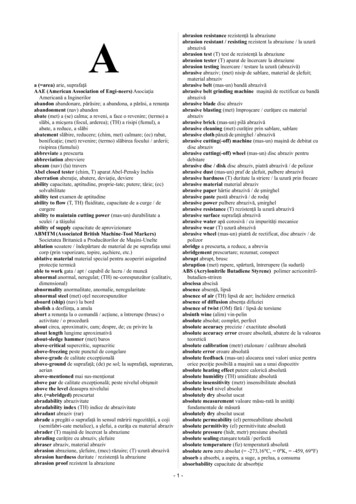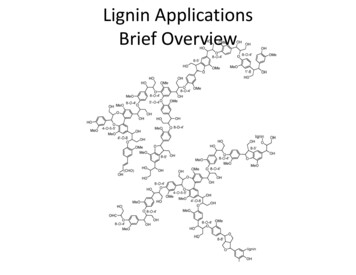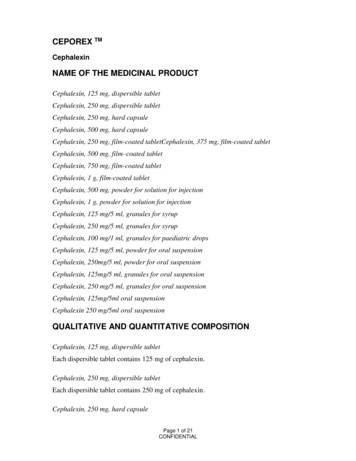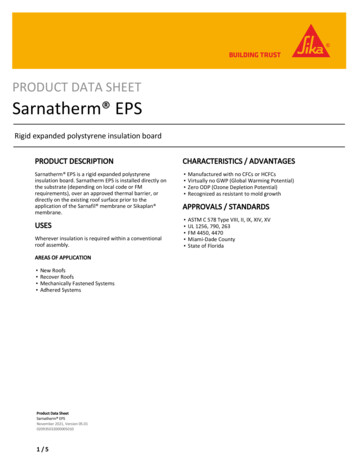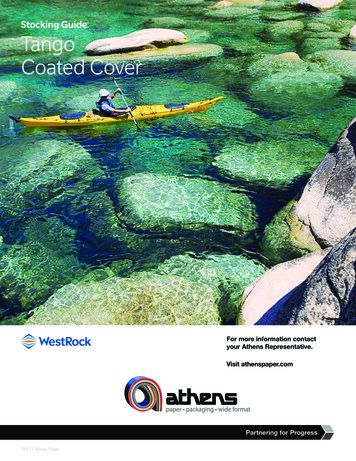
Transcription
Sains Malaysiana 49(9)(2020): 12Lignin-Coated Polystyrene/Trichloromethylsilane Absorbent for Oil Spill Cleanup(Penyerap Polistirena/Triklorometilsilana Bersalut Lignin untuk Pembersihan Tumpahan Minyak)N UR A MALINA A ZHAR, N ADIA A DRUS, W AN A IZAN W AN R AHMAN & R OHAH A. M AJID*ABSTRACTThe study was conducted to determine the effectiveness of lignin-polystyrene/ trichloromethylsilane (TL-PS) absorbent inremoving oil spillage from wastewater. Lignin powder obtained from the delignification of oil palm empty fruit bunch(OPEFB) was coated with PS emulsion (PSE) at various concentrations (2, 4, 6, & 8 mL) in order to bind the powder intoan aggregated form. Later, L-PS was exposed to trichloromethylsilane (TCMS) via chemical vapour deposition method(CVD) at fixed 7.5 min exposure time to form TL-PS absorbent. The wettability of TL-PS was determined by conductingwater contact angle (WCA) measurement and oil sorption capacity. It was found that TL-PS4 sample (immersed in 8mL PSE) had the highest WCA value (134.10 ) and oil sorption capacity (52%) in comparison with L-PS4 (immersed in8 mL PSE without TCMS) with WCA value of 99.10 and oil sorption capacity of 40%. Meanwhile, the disappearanceof hydroxyl group (OH) at peak 3429 cm-1 and appearance of siloxane bonds (R-Si-O) at peak in range of 1000 1100 cm-1 and 3.9 - 4.0 ppm had confirmed the substitution occurred between these groups, as shown by the spectraobtained from attenuated total reflectance-Fourier transform infrared (ATR-FTIR) and nuclear magnetic resonance(NMR). Thermal stability of TL-PS4 (onset degradation temperature at 252 C) was higher when compared with lignin(onset degradation temperature at 40 C), as showed by the thermogravimetric analysis (TGA). Meanwhile, the surfaceof absorbent had change from smooth (L-PS4) to rough (TL-PS4) corresponding to the deposition of silane particles ontothe surface of L-PS after the exposure with TCMS, as shown by the scanning electron microscopy (SEM). The resultssuggested that TL-PS has a promising potential to be used as an absorbent for oil spill cleanup.Keywords: Chemical vapour deposition; lignin; oil spillage; polystyrene; trichloromethylsilaneABSTRAKKajian ini telah dijalankan untuk menentukan keberkesanan serapan lignin-polistirena/triklorometilsilana (TL-PS)dalam mengasingkan tumpahan minyak daripada sisa air buangan. Serbuk lignin yang diperoleh daripada prosesnyahlignin tandan kosong kelapa sawit (OPEFB) telah disalut dengan emulsi PS (PSE) pada kepekatan yang berlainan (2,4, 6 & 8 mL) untuk mengikat serbuk ke dalam bentuk bergumpal. Kemudian, L-PS didedahkan kepada triklorometilsilana(TCMS) melalui kaedah pemendapan wap kimia (CVD) pada masa yang ditetapkan iaitu 7.5 minit waktu pendedahanbagi menghasilkan penyerap TL-PS. Tahap pembasahan TL-PS telah ditentukan dengan menggunakan pengukuransudut permukaan air (WCA) dan peratusan kapasiti penyerapan minyak. Bahan sampel TL-PS4 (yang direndam didalam 8 mL PSE) menunjukkan nilai WCA yang tertinggi (134.10º) dan peratusan kapasiti minyak penyerapanmeningkat kepada kira-kira 52% berbanding dengan L-PS4 (direndam dalam 8 mL PSE tanpa TCMS) dengan nilaiWCA bersamaan 99.10 dan kapasiti penyerapan minyak pada 40%. Sementara itu, penyingkiran kumpulan hidrosil(OH) pada puncak 3429 cm-1 dan kehadiran ikatan siloksana (R-Si-O) pada puncak dalam lingkungan 1000 - 1100cm-1 dan 3.9 - 4.0 ppm mengesahkan penggantian telah berlaku antara kumpulan ini, seperti yang ditunjukkan olehspektra analisis spektroskopi inframerah (ATR-FTIR) dan resonans magnetik nuklear (NMR). Kestabilan TL-PS terhadapsuhu (suhu permulaan degradasi pada 252.41 C) adalah lebih tinggi apabila dibandingkan dengan lignin (suhupermulaan degradasi pada 40 C), seperti yang ditunjukkan oleh analisis haba gravimetrik (TGA). Sementara itu,permukaan penyerap telah bertukar dari permukaan yang licin (L-PS4) kepada permukaan yang kasar (TL-PS) sepadandengan pemendapan zarah silina ke permukaan L-PS selepas terdedah kepada TCMS, seperti yang ditunjukkan olehmikroskop pengimbasan elektron (SEM). Keputusan ini mencadangkan bahawa TL-PS berpotensi untuk digunakansebagai penyerap bagi pembersihan tumpahan minyak.Kata kunci: Lignin; polisterina; teknik pemendapan wap kimia; triklorometilsilina; tumpahan minyak
2142I NTRODUCTIONWater contamination with oil spillage is considered asa crucial concern for environmental safety. Most of thehydrocarbon compounds that floating on the watersurface are threatening consequences and toxicity tohuman respiratory system, skin and eye irritation, marinelife, and ecosystem health (Yi et al. 2011). A continuousincrease in water vehicles during transportation, globalindustrial effluents (food industries, petrochemicals,textiles, steels) and human activities are the majorfactors which lead to catastrophic disasters to the oceansand environmental pollution (Doshi et al. 2018; Gupta et al.2004). Large accidents occurred in Gulf Coast Mexico in2010, and Exxon-Voldez oil spill in 1989 are examplesof oil spillages that have badly affected the marine ecology(Michel & Fingas 2016; Yuan et al. 2018; Zhang et al.2018). Many methods and technologies are utilized todeal with the issues of oil spillages in water includingin-situ burning, chemical dispersants, mechanicalskimming and manual labour (Liu et al. 2019). However,these methods give a long term effect, non-environmentalfriendly and costly (Babiker et al. 2019; Liu et al. 2019).Another technique to control the oil spillage is byusing absorbents. They are made of natural absorbents(such as peat moss, sawdust, and clay) or the syntheticmaterials (such as polypropylene). Absorbents are widely,used to remove the final traces of oil on shoreline orin areas that cannot be reached by other clean-uptechniques.The use of agro waste- or biomass-based absorbentscoupled with low surface tension materials such assilane- or silicone-based compounds have attracted manyattentions due to their higher oil sorption capacities and alsobiomasses are renewable environmental friendly resourcesand cheap (Liu et al. 2014; Pour et al. 2019; Wang et al.2012). For examples, Babiker et al. (2019) had prepareda superhydrophobic methylcellulose/poly(acrylic acid).coated with trichloromethylsilane (TCMS) absorbent viachemical vapour deposition (VCD) method. Liu et al.(2014) had fabricated a silane coated with silicone dioxide(SiO2) nanoparticle absorbent via a sol-gel process. Wang etal. (2012) had successfully prepared a superhydrophobic/oleophilic kapok fibre/silica nanoparticles modified withdodecyltrimethoxysilane (DTMS) oil sorbent. Amongthe abundant and cheap natural biomassess, lignin thatderived from cellulosic biofuel or papermaking industrieshas the potential to be used as an absorbent. Lignin isan amorphous polyaromatic polyol which consists ofprecursor inter-unit linkages that have potential to reactwith other materials (Figure 1).Kai et al. (2015) had developed a series ofpoly(ethylene glycol) methyl ether methacrylate (PEGMA)grafted-lignin hyper-branched copolymer for a smartbiomaterial for biomedical application. Meanwhile,Ghavidel et al. (2019) had prepared Kraft lignin-PSabsorbent via free radical polymerization for copper ionsadsorption.In our previous work, a hydrophobic/oleophiliclignin treated with TCMS (Li-TCMS) oil sorption viaVCD method had been successfully prepared (Azharet al. 2019). It was found that Li-TCMS absorbent hasimproved the oil sorption percentages compared with theuntreated lignin. The reason is due to the hydroxyl groups(OH) of lignin has been replaced by the silane groups ofTCMS, thus increasing the hydrophobic/oleophilic natureof Li-TCMS absorbent. However, since the Li-TCMS isin a powder/loose form, it tends to scatter in water ratherthan stay in the aggregated form. Hence, to overcome thisdrawback, we have made some modifications by coatingthe lignin first with polystyrene (PS) before subsequentlydeposited with TCMS through the VCD technique. PS wasselected as a binder because it possesses a hydrophobicoleophilic property, owing to the presence of benzene ringin its molecular structure. A study by Li et al. (2014) hadgrafted styrene onto dealkaline lignin has been achievedsuccessfully and the chemical reaction as Figure 1. Yang etal. (2017) had coated kapok fibre with PS resin and foundthat the oil sorption capacity had increased compared tothe kapok alone. Furthermore, it showed good buoyancyon the water surface and good reusability in oil/waterseparation cycle. Hence, for our work, we used PS emulsion(PSE) instead of PS resin because it is an eco-friendlybinder with low volatile organic compound (VOC) and iteasily coats the surface of lignin since it is a water basedsystem.FIGURE 1. Illustration of lignin grafted PS copolymer (Li et al. 2014)
2143MATERIALSLignin was obtained from the delignification of oil palmempty fruit bunch (OPEFB) using sodium hydroxide( N a OH ) and sulphuric acid ( H 2SO 4) purchased fromMerck Sdn. Bhd. OPEFB was collected from oil palmplantation in Mersing, Johor. Polystyrene emulsion(PL 1292) was provided by Synthomer Sdn. Bhd.Tetrachloromethylsilane (TCMS) was bought from SigmaAldrich and distilled water was obtained from Biopolymerlaboratory, UTM.PREPARATION OF LIGNIN-POLYSTYRENE/TCMS ABSORBENTDELIGNIFICATION OF OPEFBAbout 80 g of OPEFBs were cooked in a diluted 10%w/v of sodium hydroxide (NaOH) solution at 80 C for 2h. The fibrous materials were strained through a strainerand a black liquor was collected. Later, about 10% w/v ofsulphuric acid was slowly added into the black liquor toreach pH 3. The liquor was filtered through a mesh clothand the residue (lignin) was collected. The lignin waswashed with copious amount of distilled water until itreached pH 7. The collected solid lignin was oven-driedovernight at 60 C and was kept in a desiccator for furtheruse.LIGNIN COATED POLYSTYRENE EMULSIONAbout 0.2 g of lignin was mixed with PS emulsion in astainless steel container according to the formulationsshown in Table 1. After 1 min of stirring, lignin-coatedPS (L-PS) was dried in the oven at 60 C until a constantweight was achieved.PREPARATION OF TL-PS ABSORBENT VIA CHEMICALVAPOUR DEPOSITION METHODA non-woven tea bag containing 2 g of L-PS was placedin a sealed flask filled with 12 mL of TCMS. The sealedflask was placed in oven at temperature of 60 C for 7.5min to allow the deposition of TCMS onto the L-PS surface.The silane groups in the TCMS vapour had replacingthe hydroxyl groups (OH) of lignin while releasing thehydrogen chloride (HCl). The obtained TL-PS was washedwith distilled water to remove traces of HCl groupsfrom the surface of the L-PS. The deposition techniquewas adopted from the works done by Azhar et al. (2019)and Tejado et al. (2014). The sample was dried in theoven overnight and was kept in desiccator for furthercharacterizations.TABLE 1. Formulation of TL-PS at fixed TCMS content and exposure timeSample codeLignin (g)PS emulsion HOBICITY, OLEO SORPTION CAPACITY ANDREUSABILITY TEST OF TL-PS ABSORBENTThe degree of hydrophobicity of TL-PS was determinedusing a water contact angle (WCA) measurement with adynamic sessile drop technique. About 2 μL of distilledwater was dropped onto the sample using a micro-syringeat room temperature. An average of five readings ofcontact angle was taken from each sample. A digitalcamera was used to capture the droplet image. The anglevalue that 90 indicates a hydrophobic character (Cunhaet al. 2010). Meanwhile, the oil-sorption capacities oflignin-coated PS/TCMS samples were measured. About0.2 g sample was immersed into a cooking oil for 1 min.The sample was taken out from the oil and was placedon the wire mesh to remove the excess oil. The oilsorption capacity (Q) of the sample was calculated using(1) (Oribayo et al. 2017). The reusability of the treatedlignin-coated-PS was evaluated by repeating the sorptionfor 15 days.Q Mt MiMi(1)where Q is the oil sorption capacity of the sorbent; Mt isthe weight of wet sorbent after draining (g); and Mi isthe initial weight of sorbent (g).CHARACTERIZATIONS AND THERMAL STABILITY TEST OFTL-PS ABSORBENTThe functional groups of uncoated lignin and TL-PSsamples were identified by using an attenuated totalreflectance-Fourier transform infrared (ATR-FTIR) model
2144Shimadzu IR Tracer 100 at 4 cm-1 resolution, 32 scansand the wavenumbers ranging from 4000 to 500 cm-1 atroom temperature. Further identification was conductedusing a Bruker Advance/DMX 400 MHz NMR spectrometerwith 16 scans for a proton nuclear magnetic resonance(1H-NMR) and a carbon proton nuclear magnetic resonance(13C-NMR). About 100 mg of lignin and TL-PS sampleswere dissolved in 500 μL of DMSO and CDCl3, respectively.The thermal stabilities of samples were measured byusing a Perkin Elmer TGA4000 thermogravimetric analysis(TGA) with a heating rate of 10 C/min from ambienttemperature to 900 C and under a nitrogen flow of 20 mL/min. For surface morphologies, the samples were analysedusing a scanning electron microscope (SEM) modelEMLEO SUPRA 35VP, where the cryo-fractured sampleswere coated with gold sputtering prior to examination.RESULTS AND DISCUSSIONWATER CONTACT ANGLE MEASUREMENT HYDROPHOBICAND OLEOPHILIC SURFACEResults of WCAs for TL-PS samples are shown in Figure3(a) and Table 2. It can be seen that WCA values increasedwith increasing PS volumes and all TL-PS samples hadWCAs higher than of sample L-PS4 (without TCMS).These indicated that the presence of TCMS had increasedthe hydrophobic characters of samples. As a comparison,sample TL-PS4 exhibited the highest WCA of 134.10 which was about 35% higher than that of sample L-PS4,although both samples were immersed in the same amountof PSE (i.e. 8 mL). This can be explained as follows;silane groups of TCMS had replaced the hydroxyl groupsof lignin, hence producing the silylated external andFIGURE 2. Schematic illustration of the fabrication processes oftreated lignin-coated-PSSCHEME 1. Substitution between OH of lignin with hydrolysed silaneof TCMS (Cunha et al. 2010)SCHEME 1. Substitution between OH of lignin with hydrolysed silane of TCMS (Cunha et al.2010)
2145internal micropores surfaces of sample (Figure 2 andScheme 1). The substitution between these hydrophilichydrophobic groups had made the TL-PS4 became morehydrophobic. The same findings were reported byBogdan and Kulmala (2006) and Cunha et al. (2010).However, since the amount of TCMS (0.2 g), theexposure time (7.5 min) and the coating period of ligninPSE (1 min) were fixed for all samples, the only variableleft was the amount of PSE used to coat the lignin. HigherPSE volume, meanings more PS available to coat thesurface of the lignin, thus increasing its hydrophobicity.The explanations are as follows; PSE consists of theemulsified PS particles in water medium; hence, PSE caneasily coat the surface of lignin due to the formation ofhydrogen bonding between the OH groups of lignin andthe OH groups of water. When the water evaporated, PSparticles diffused and form continuous film that coatedthe surface of lignin. Since PS is a hydrophobic polymer,owing to the aromatic ring and the ethylene group in itsmolecular structure, PS can contribute to the increaseof the hydrophobicity of TL-PS, as shown by the sessiledrops in Figure 3(a). PS materials play an important rolewhere it influences the wettability and amphiphilicity ofthe absorbents (Li et al. 2008; Vince et al. 2006; Wang etal. 2012).Meanwhile, for the oil sorption capacity (Figure 3(a)),all samples were able to absorb the oil in the range of40-52% in day 7 with relative to the day 0. Sample TL-PS4had the highest sorption capacity of 52% where no tracesof oil seen left on the surfaces of water, as illustrated inFigure 4. After day 7, the sorption capacities of all samplesstarted to decrease steadily, but still averagely higher thanthat of sample L-PS4. This was thought due to all sampleshad reach their saturation points as the pores in lignincannot absorbed more oil. These results also reflected tothe reusability of the samples that were repeated for 15days and their efficiencies started to level-off starting atday 7. The findings are in agreement with other workers(Wang et al. 2013).FIGURE 3. The results of (a) water contact angles and (b) oilabsorption capacity for treated lignin-coated-PS samples
2146FIGURE 4. The illustration of oil clean-up by sample TL-PS4 (a) oil-watermixture before immersion (b) immersion of the sample into oil-watermixture for 1 min (0 day) and (c) no trace of oil layer left in day 7The summaries of WCAs and oil sorption capacities of all samples are shown in Table 2.TABLE 2. WCA and oil sorption capacity of TL-PS samples and L-PS4SampleWCA(0)L-PS4Oil sorption capacity, %*0 day1 day2 day3 day5 day7 day12 day15 1*Immersion in oil-water mixture for 1 minIDENTIFICATION OF THE FUNCTIONAL GROUPS OF TL-PSABSORBENTThe ATR-FTIR spectra of lignin, L-PS4 and TL-PS4 sampleswere shown in Figure 5. It can be seen that commonpeaks for lignin were observed at 3000-3500 cm-1 and2800-2900 cm-1, corresponding to -OH stretching andC-H vibration, respectively. Meanwhile, the detection ofpeaks at 1600-1650 cm-1 were attributed to the presenceof C-C stretching of the aromatic rings in lignin. Otherworks had also observed these peaks (Asim et al. 2015;Zhang et al. 2017).For sample L-PS4, the intensity of the -OH groupswere reduced, and the peak was shifted to the right(from 3498 to 3429 cm-1), indicating the formation ofbonded -OH groups. This supported the explanations onthe formation of hydrogen bonding between OH groupsof lignin and OH groups of water of PES. In addition, astrong band was detected at 780 cm-1, attributed to themonosubstituted aromatic nuclei of PS, as reported byother researchers (Ghavidel & Fatehi 2019; Zhang et al.2017). For sample TL-PS4, the OH-peak had disappeareddue to the substitution with silane groups of TCMS, asdetected at 1000-1100 cm-1, corresponded to the presenceof weak shoulder peak of siloxane-based groups (i.e.Si-O-C and Si-O-Si) stretching bands (Wang et al. 2012).These peaks were overlapped with the large and intenselignin C-O stretching bands at 1050 cm-1 (Azhar et al.2019; Cappelletto et al. 2012; Yang et al. 2017).
2147FIGURE 5. FTIR spectra of lignin, L-PS4 and TL-PS4The chemical compositions of lignin and TL-PS4were confirmed with the 1H-NMR spectra as shown inFigure 6(a). Wide and intense chemical shifts wereobserved in the region of 3.64 ppm and 0-1.5 ppm whichcorresponding to the methoxyl group and hydrocarbonchains of lignin, respectively. The hydroxyl groups weredetected in the regions of 7.0-7.5 ppm. In the case ofTL-PS4, the disappearance of hydroxyl peak and theappearance of siloxane bonds (-Si-O-R) as detected at3.9-4.0 ppm was related to the removal of OH groupsand the substitution of silane groups. Meanwhile, thechemical shifting at 0.5-2.5 ppm, was belong to aliphatichydrogen of PS that coated the lignin, as reported by Li etal. (2015) and Wang et al. (2013). For 13C-NMR spectra inFigure 6(b), the detection of intense chemical shifting at13.7 ppm and 19.10 ppm were attributed to the methoxylgroups of lignin that produced from the reaction betweenthe carboxyl carbon of lignin and silane of TCMS (Anju& Narayanankutty 2017; Salon et al. 2005).The findings from FTIR and NMR supported theexplanations on the increase of WCA and oil sorptioncapacity when lignin was coated with PSE and TCMS.
2148FIGURE 6. The results of (a)1H-NMR spectroscopy and (b) 13C-NMRspectroscopy for lignin and TL-PS4THERMAL STABILITIES OF LIGNIN AND TL-PS4The plots of thermal stabilities of lignin and TL-PS4 wereshown in Figure 6. There are three thermal decompositionsteps observed for lignin and two decomposition stepsfor TL-PS4 during the heating process; lignin underwentthe thermal degradation, starting from 30 to 141 C with7.08% weight loss, corresponding to the volatilizationof water molecules contained in the sample. Furtherheating the lignin from 141 to 460 C showed weight lostaround 55.46%, attributed to the elimination of water,carbon monoxide, carbon dioxide and methane. The thirddecomposition step occurred in the temperature rangesof 460 to 900 C with about 24% weight loss, relatedto the pyrolytic degradation of the lignin backbonestructure which released carbon dioxide, monomericphenols and some aromatic rings into the vapour phase,as reported by Li et al. (2015). Meanwhile for TL-PS4,the first decomposition step occurred in the range of 30to 430 C, which can be ascribed to the breakage of theshort molecule such as styrene, together with other lowmolecular weight compounds from lignin such as waterand carbon dioxide. As comparison, sample TL-PS4showed higher thermal stability (onset temperature at450 C) than lignin (onset temperature at 140 C) whichmight be attributed to the silane particles structure inthe absorbent. Further heating from 430 to 900 C hadshown a subtle degradation profile which related to thepyrolytic degradation of the lignin backbone structure.As comparison, at 900 C, sample TL-PS4 had more weightloss (7%) than lignin (13%).FIGURE 6. TGA spectra of lignin and TL-PS4
2149SURFACE MORPHOLOGYSurface morphologies of lignin, L-PS 4 and TL-PS 4samples were illustrated in Figure 7(a)-7(c). It can beclearly seen that lignin showed a smooth surface ofsingle fibril (Figure 7(a)). When lignin was immersedin PSE, the PS particles diffused with each other whenwater evaporated, thus forming a film on the surface oflignin (L-PS) as shown in Figure 7(b). This observationwas consistent with the works reported by Ghavidel andFatehi (2019). As the L-PS was exposed to TCMS vapour,the siloxane of TCMS replaced the OH groups of lignin,thus forming the silane. The deposition of silane particleson the surface of lignin resulted rough surfaces as shownin Figure 7(c). The rough surface increased the surfacearea and oil retention ability, thus generating high oilsorption capacity. The latter finding supported the resultsfrom WCA and oil absorbent capacity of sample TL-PS4.FIGURE 7. SEM micrographs of (a) lignin, (b) L-PS4 and (c) TL-PS4CONCLUSIONLignin-coated with PS/TCMS absorbent was successfullyprepared by vapour deposition method (VCD). Results fromATR-FTIR and NMR had confirmed the reaction betweenOH groups of lignin and silane groups of TCMS with thedisappearance of OH groups of lignin and the appearance ofsiloxane bonds (-Si-O-R) in TL-PS sample. The substitutionbetween OH and silane had increased the WCA (134.10 )and the oil sorption capacity (52%) of TL-PS4. High PSEvolume used to coat the lignin was also contributed to theincrease of both properties. In addition, sample TL-PS4also showed high thermal stability on the temperaturesranging from 30 to 430 C. Beyond that, lignin had betterthermal stability as shown by TGA. The deposition ofsilane particles on the surface of lignin had resultedrough surface as shown by SEM microimage. This roughsurface provided large surface area and oil retention abilityto the sample, thus increasing the oil sorption capacity. Inconclusion, lignin-coated PS/TCMS has potential to beused as an absorbent for oil-spill clean-up.ACKNOWLEDGEMENTSThe authors would like to express their appreciations forthe financial support from Universiti Teknologi Malaysiafor furbishing the grants to expedite the researchwork (GUP vot: Q.J130000.2546.14H38; UTMFR votQ.J130000.2551.21H00).REFERENCESAnju, V.P. & Narayanankutty, S.K. 2017. Impact of Bis-(3triethylsilylpropyl) tetrasulphide in the properties of PMMA/cellulose composite. Polymer 119: 224-237.Asim, M., Abdan, K., Jawaid, M., Nasir, M., Dashtizaleh, Z.,Ishak, M.R. & Hoque, M.E. 2015. A review on pineappleleaves fibre and its composites. International Journal ofPolymer Science 2015(6): 1-16.Azhar, N.A., Rahman, W.A.W. & Majid, R.A. 2019. Lignintreated-trichloromethylsilane sorbent for oil spill cleanup.Journal of Energy and Safety Technology 1(2): 43-49.Babiker, D.M.D., Zhu, L., Yagoub, H., Xu, X., Zhang, X.,Shibraen, M.H.M.A. & Yang, S. 2019. Hydrogen-bondedmethylcellulose/poly(acrylic acid) complex membranefor oil-water separation. Surface & Coatings Technology367: 49-57.Bogdan, A. & Kulmala, M. 2006. Encyclopedia of Surface andColloid Science. 2nd edition. New York: Taylor & Francis.Capelletto, E., Callone, E., Campostrini, R., Girardi, F.,Maggini, S., Volpe, C.D., Siboni, S. & Maggio, R.D.2012. Hydrophobic siloxane paper coatings: The effectof increasing methyl substitution. Journal Sol-gel ScienceTechnology. 62: 441-452.Cunha, A.G., Freire, C., Sivestre, A., Neto, C.P., Gandini,A., Belgacem, M.N., Chaussy, D. & Beneventi, D. 2010.Preparation of highly hydrophobic and lipophobic cellulosefibers by a straightforward gas-solid reaction. JournalColloid and Interface Science 344(2): 588-595.
2150Doshi, B., Sillanpää, M. & Kalliola, S. 2018. A review of biobased materials for oil spill treatment. Water Research 135:262-277.Ghavidel, F. & Fatehi, P. 2019. Synergistic effect of ligninincorporation into polystyrene for producing sustainablesuperadsorbent. RSC Advances 9: 17639-17652.Gupta, R., Gupta, N. & Rathi, P. 2004. Bacterial lipases: Anoverview of production, purification and biochemicalproperties. Application Microbiology Biotechnology 64(6):763-781.Kai, D., Low, Z., Liow, S.S., Karim, A.A., Ye, H., Jin, G., Li, K.& Loh, X.J. 2015. Development of lignin supramolecularhydrogels with mechanically responsive and self-healingproperties. ACS Sustainable Chemistry Engineering 3(9):2160-2169.Li, H., Zhang, Q., Gao, P. & Wang, L. 2015. Preparation andcharacterization of graft copolymer from dealkaline ligninand styrene. Journal of Applied Polymer Science 132(17):1-9.Li, S.H., Zhang, S.B. & Wang, X.H. 2008. Fabrication ofsuperhydrophobic cellulose-based materials through asolution-immersion process. Langmuir 24(10): 5585-5590.Liu, F., Ma, M., Zang, D., Gao, Z. & Wang, C. 2014. Fabricationof superhydrophobic/superoleophilic cotton for applicationin the field of water/oil seperation. Carbohydrates Polymers103: 480-487.Liu, Y., Liu, N., Jing, Y., Jiang, Y., Yu, L. & Yan, X. 2019.Surface design of durable and recyclable superhydrophobicmaterials for oil/water separation. Colloids and Surfaces A567: 128-138.Michel, J. & Fingas, M. 2016. Oil spills: Causes, consequences,prevention and counter measure. In Fossil Fuels, editedCrawley, G.M. Singapore: World Scientific PublishingCompany. pp. 159-201.Oribayo, O., Feng, X., Rempel, G.L. & Pan, Q. 2017. Synthesisof lignin-based polyurethane/graphene oxide foam andits application as an absorbent for oil spill clean-ups andrecovery. Chemical Engineering Journal 323: 191-202.Pour, F.Z., Karimi, H. & Avargani, V.M. 2019. Preparation of asuperhydrophobic and superoleophilic polyester textile bychemical vapor deposition of dichloromethylsilane forwater-oil separation. Polyhedron 159: 54-63.Salon, M.B., Abdelmouleh, M., Boufi, S., Belgacem, M.N. &Gandini, A. 2005. Silane adsorption onto cellulose fibers:Hydrolysis and condensation reactions. Journal of Colloidand Interface Science 289(1): 249-261.Tejado, A., Chen, W.C., Abim, M.N. & van de Ven, T.G.M.2014. Superhydrophobic foam-likecellulose made ofhydrophobized cellulose fibres. Cellulose 21: 1735-1743.Vince, J., Vilcknik, B.A., Fir, M., Vuk, A.S., Jovanovski, V.& Simoncic, B. 2006. Structural and water-repellentproperties of a urea/poly(dimethylsiloxane) sol-gel hybridand its bonding to cotton fabric. Langmuir 22(15): 6489-6497.Wang, J., Zheng, Y. & Wang, A. 2013. Coated kapok fiber forremoval of spilled oil. Marine Bulletin 69(1-2): 91-96.Wang, J., Zheng, Y. & Wang, A. 2012. Superhydropobic kapokfiber oil-absorbent: Preparation and high oil absorbency.Chemical Engineering Journal 213: 1-7.Yang, J., Li, H., Lan, T., Peng, L., Cui, R. & Yang, H. 2017.Preparation, characterization, and properties of fluorinefree superhydrophobic paper based on layer-by-layerassembly. Carbohydrate Polymers 178: 228-237.Yi, Y., Yang, Z. & Zhang, S. 2011. Ecological risk assessmentof heavy metals in sodiment and human health riskassessment of heavy metals in fishes in the middle andlower reacher of the Yangtze River basin. EnvironmentalPollution 159(10): 2575-2585.Yuan, J., Gao, R., Wang, Y., Cao, W., Dong, B. & Dou, J. 2018. Anovel hydrophobic adsorbent of electrospun SiO2@MUF/PAN nanofibrous membrane and its adsorption behaviourfor oil and organic solvents. Journal Material Science 53:16357-16370.Zhang, T., Li, Z., Lü, Y., Liu, Y., Yang, D., Li, Q. & Qiu, F.2018. Recent progress and future prospects of oil-absorbingmaterials. Chinese Journal of Chemical Engineering 27(6):1282-1295.Zhang, Z., Zhang, Y., Lin, Z., Mulyadi, A., Mu, W. & Deng, Y.2017. Butryric anhydride modified lignin and its oil-waterinterfacial properties. Chemical Engineering Science 165:55-64.Nur Amalina Azhar, Nadia Adrus & Wan Aizan Wan RahmanSchool of Chemical and Energy EngineeringUniversiti Teknologi Malaysia81310 Skudai, Johor Darul TakzimMalaysiaRohah A. Majid*Centre for Advanced Composite MaterialsUniversiti Teknologi Malaysia81310 Skudai, Johor Darul TakzimMalaysia*Corresponding author; email: r-rohah@utm.myReceived: 16 January 2020Accepted: 10 May 2020
2010, and Exxon-Voldez oil spill in 1989 are examples of oil spillages that have badly affected the marine ecology (Michel & Fingas 2016; Yuan et al. 2018; Zhang et al. 2018). Many methods and technologies are utilized to deal with the issues of oil spillages in water including in-situ burning, chemical dispersants, mechanical
